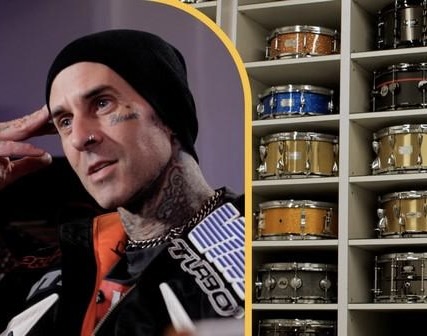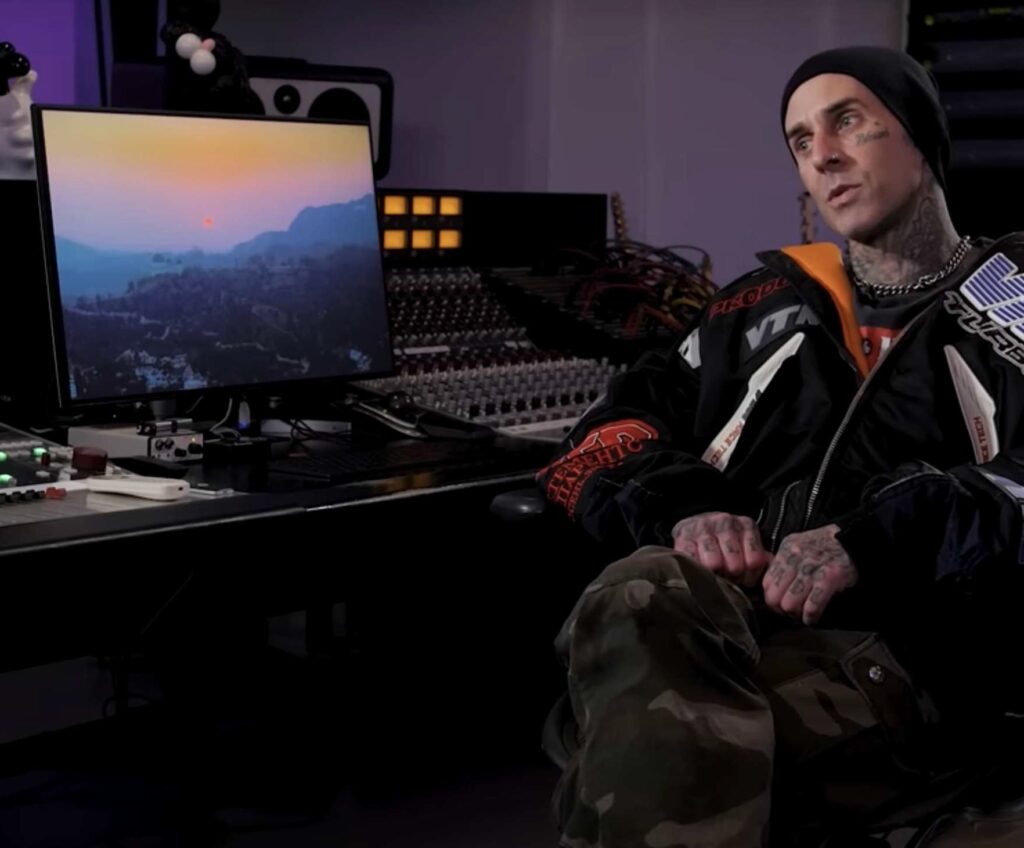For three decades, Travis Barker has been more than a drummer — he has been a cultural engine. As the backbone of Blink-182, he transformed skate-punk anthems into mainstream hits. As a collaborator, he crossed genre lines, bridging the worlds of rap, pop, and hardcore with percussive precision. Today, Barker’s story is no longer confined to the stage. It lives inside the walls of Beat Laboratories, his Los Angeles studio, which has become a crucible where punk’s rebellious DNA merges with modern sound design.
The studio is more than a creative workspace. It is a home — a culture hub where artists converge to make music that resonates with urgency, angst, and experimentation. In tracing its evolution, one can see how Barker’s personal journey has mirrored the rise, fall, and revival of punk’s modern identity.
Beat Laboratories: A Creative Sanctuary
Beat Laboratories, affectionately known as “The Lab,” is situated in Los Angeles, not far from the neighborhoods where Barker cut his teeth as a young drummer. Unlike traditional studios, with their sterile and glossy interiors, The Lab exudes a punk ethos. Its walls are covered with graffiti, band posters, and visual reminders of the DIY ethos that birthed punk.
The gear is extensive — racks of drums, vintage snares, modular synths, and mixing consoles stacked with effects pedals. Yet the setup feels personal, almost chaotic, as if the environment itself insists on spontaneity. Barker has described the studio not as a business enterprise but as a place where friends and collaborators can feel free to push boundaries without corporate oversight.
Punk Meets Technology
What distinguishes Beat Laboratories is its marriage of analog grit with digital innovation. Barker is a drummer who still prizes the tactile feedback of a snare hit, the imperfections of live performance. But inside The Lab, he pairs that authenticity with cutting-edge production technology.
Sessions often begin with Barker laying down live drum tracks, which are then looped, sampled, and distorted. These beats can morph into punk anthems or transform into the backbone of a trap record. The flexibility of The Lab has made it a rare space where punk’s raw immediacy doesn’t get lost in digital polish. Instead, it’s amplified, made sharper and more unpredictable.
For younger artists raised on laptops and drum machines, working in Beat Laboratories means being initiated into the organic chaos of live instrumentation. For veterans, it’s a chance to reconnect with the energy that made punk disruptive in the first place.
Flow
One cannot separate Beat Laboratories from the collaborative energy it cultivates. Barker has hosted a rotating cast of artists: pop-punk revivalists, hip-hop heavyweights, indie outsiders, and EDM producers. Each session feels less like a job and more like an experiment in community.
Machine Gun Kelly’s Tickets to My Downfall was one of the most visible examples of The Lab’s output — a pop-punk record that revived mainstream interest in the genre. Willow Smith, Jxdn, and Trippie Redd have all recorded within its walls, crafting music that bends genres but carries the urgency of punk.
The Lab’s environment encourages risk. Barker’s drumming is often the spark, but his willingness to adapt, co-produce, and arrange gives artists the confidence to chase unorthodox ideas. For a generation skeptical of the music industry’s machinery, Beat Laboratories offers something rare: authenticity.
From Blink-182 to Beat Labs: Continuity in Rebellion
At its core, Beat Laboratories continues the work that began when Blink-182 crashed onto MTV in the late 1990s. Back then, punk was sneered at by mainstream critics, dismissed as juvenile. Barker’s playing proved otherwise — technical, ferocious, and inventive, he gave Blink’s pop hooks a backbone of legitimacy.
The studio is a natural extension of that ethos. Just as Blink brought punk from clubs into suburban bedrooms, Beat Laboratories brings punk sensibilities into the modern music landscape. The artists who pass through are not just making records; they are inheriting a tradition of rebellion. Whether the output is a hardcore track, a rap single, or a hybrid, the spirit remains the same: challenge authority, embrace chaos, and make noise that matters.
Punk’s Modern Home
Calling Beat Laboratories “punk’s modern home” is not hyperbole. In an era where punk bands fight for attention in algorithm-driven playlists, The Lab preserves a sense of place. It’s where community happens, where bands still plug in amps and thrash, where songs are written in sweat rather than spreadsheets.
Yet it also reflects how punk has grown. The Lab is not exclusive; it is porous. Rap, pop, and punk all collide here, proving that the genre is less a sound and more a way of being. Barker insists that punk’s essence lies in honesty, and that essence translates whether it’s delivered through a three-chord progression or a trap beat.
Impression
The existence of Beat Laboratories has cultural weight beyond music. It has become a symbol of how punk refuses to die — instead, it adapts. Young artists idolize Barker not only for his playing but for his willingness to share space, to make the studio a communal resource rather than a fortress.
Social media amplifies this resonance. Clips from The Lab, whether Barker hammering out fills or an artist previewing a new hook, spread virally. Each post functions as both promotion and proof that punk’s fire still burns in unexpected places. The Lab is not hidden; it is performative, a stage in itself that keeps fans tethered to the process of creation.
Critiques and Challenges
Of course, Beat Laboratories is not without its critiques. Purists argue that punk’s soul cannot be preserved in a high-tech LA studio, that its heart belongs in dingy basements and cramped clubs. Others question whether Barker’s embrace of mainstream pop stars dilutes punk’s radical edge.
Yet these critiques are not new. Punk has always been contested terrain, its boundaries argued over by fans and gatekeepers. Beat Laboratories thrives precisely because it stirs debate, just as Blink-182 once did when they introduced humor, melody, and radio-ready hooks into a genre defined by defiance.
Future of Punk Lives Here
Beat Laboratories is not a museum of punk’s past. It is a living organism where punk’s future is being written, one session at a time. Barker’s drumming may still be the heartbeat, but the studio’s real strength lies in its openness: to collaboration, to genre-blending, to risk.
From Blink-182’s chart-topping anthems to the cross-genre experiments of today, Barker has remained faithful to one principle: punk is less about sound than about spirit. In Beat Laboratories, that spirit has a home — messy, loud, experimental, and unashamedly alive.
See more & shop his gear on Reverb: https://shorturl.at/3yijW
No comments yet.










